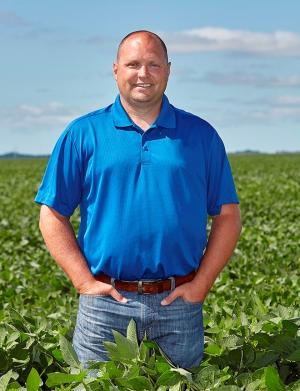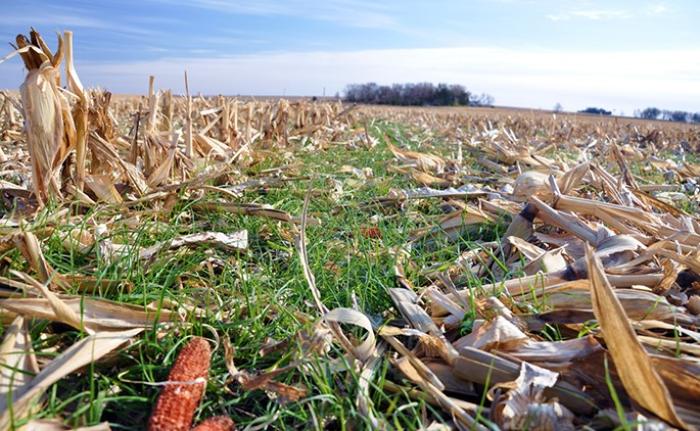Red River Valley Farm Reduces Tillage in Corn-Bean Rotation
Morken Farm, of Casselton, N.D., has squeezed several tillage passes out of its corn-soybean rotation.
NRCS-North Dakota press release – June 20, 2022

Joe and his wife, Robin, operate the farm in the Red River Valley with his parents, Harvey and Mary.
Over the past several years they have eliminated all fall tillage on soybean ground and now only make one vertical tillage pass in the spring to incorporate fertilizer before planting corn in the soybean stubble.
“I had heard guys in other parts of the country describe fall tillage after soybeans as unnecessary ‘recreational tillage,’” says Joe, who served on North Dakota Soybean Council and met many farmers from all over the U.S. “It got me thinking about why we were doing it.”
The big reason the Morkens tilled soybean stubble with a disk chisel in the fall and a disk cultivator in the spring was to reduce residue levels so their heavy clay-loam soils would dry out and warm up.
But too much tillage, or too aggressive tillage, buried nearly all the residue and exposed the soil surface to the wind.
“Wind erosion is a big problem for us,” Joe says. “We are always looking for ways to keep our fields from blowing.”
The Morkens experimented with reducing tillage after harvesting beans on just 80 acres their first year, 160 acres the second year and half their soybean acres the third year. It worked so well that now they don’t till any soybean fields in the fall, and only make one pass with the vertical tillage implement in the spring to incorporate fertilizer.
Corn more challenging
Cutting tillage in corn has been more challenging. Their high yielding corn produces a lot of residue. They tilled fields with a disk chisel in the fall and disk cultivator in the spring. But because the residue frequently plugged up in the implements – even though they were using a chopping corn head to cut the residue into small pieces -- they had to make several passes to eliminate the clumps and get the field ready for soybean planting. The tillage turned the fields black and exposed them to the wind.
One solution the Morkens came up with was to replace the disk-chisel and disk-cultivator with a vertical tillage tool. Corn residue doesn’t plug up in it. They also switched back to a non-chopping corn head. It leaves the corn stalks standing in the field, which reduces the amount of residue lying on the soil surface.
The vertical tillage implement works the soil less aggressively than the disk-chisel or disk-cultivator and leaves nearly all of the corn residue on the surface. It airs out the residue and the top few inches of the soil.
“There’s no problem planting soybeans into it,” Joe says.
The Morkens are planting a rye cover crop in some of their corn to eliminate the need for the vertical tillage pass, too. They fly on winter rye seed into corn in August. The rye germinates beneath the corn, but doesn’t get very big before winter. It survives the cold weather and starts growing again in March and early April. In May, the Morkens seed soybeans into the growing cover crop. The rye can be taller than the planter toolbar. They spray out the rye with Roundup before the soybean seedlings emerge. The practice is called “planting green.”
A good stand of rye will suppress weeds and use up excess moisture, Joe says. That eliminates the need to do tillage to prepare the seedbed for soybeans.
But the Morkens haven’t been able to get a good stand of rye every year. If it is dry in August, the rye seed may not germinate.
“If I could get an airplane to fly on the rye seed when it’s raining, it would work every time,” Joe says.
He may try other ways to interseed rye into corn that might produce more consistent results.
“I haven’t got it 100% figured out yet,” Joe says.

Getting brave
The Morkens worked with the Natural Resources Conservation Service to reduce tillage. NRCS has cost sharing grants for trying new practices that can help protect the soil and improve soil health.
“It’s a little bit scary to stop doing tillage,” Joe says. “NRCS helped me get brave enough to try it.”
He’s glad he did. Reducing tillage hasn’t hurt their net income. Plus, they are protecting their topsoil from wind erosion.
“I don’t know how to put a price on our topsoil, but it is pretty important,” Joe says.
For information on how NRCS can help you reduce tillage, see your local NRCS field office.
Media contact:
Lon Tonneson
for the Natural Resources Conservation Service - North Dakota
lon.tonneson@gmail.com
701-361-1105

